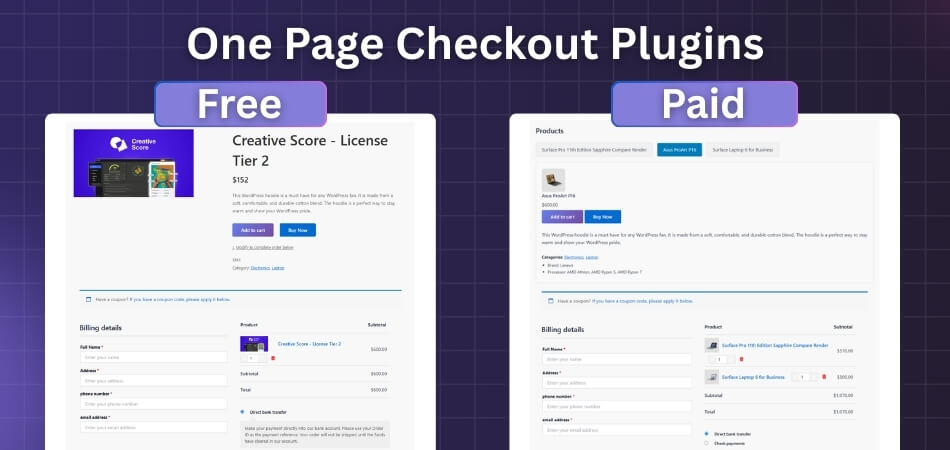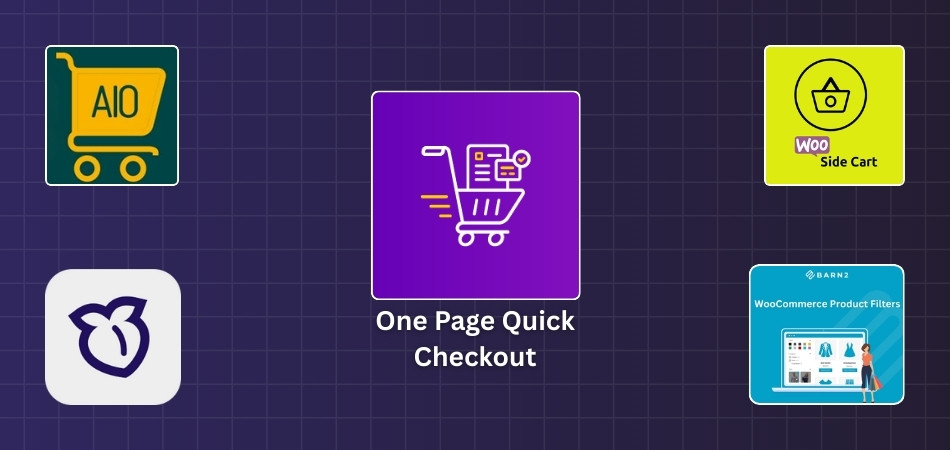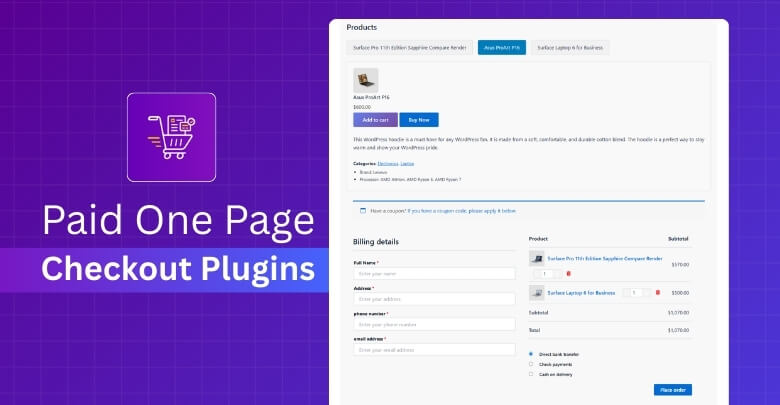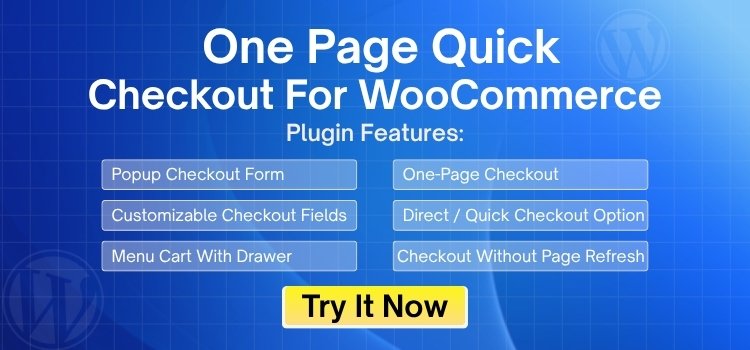One page checkout plugins make shopping faster by cutting out extra steps and keeping everything on a single screen. They help reduce cart abandonment and give buyers a smoother path to finish their order. Many store owners wonder about free vs. paid one page checkout plugins: which one should you use?
The main difference between free and paid one-page checkout plugins is feature depth. Free plugins offer basic design and field control with limited support. Paid plugins add advanced layouts, faster mobile speed, wallet support, order bumps, analytics, and regular updates. Choose paid for growth; use free for testing or small stores.
Do you want to know which option fits your store best and how each choice can impact performance, design, payments, and support? If you are curious, this article covers every detail you need to compare free and paid checkout plugins before making your decision.

Free vs. Paid One Page Checkout Plugins: Which One Should You Use?
Online stores always look for ways to make checkout faster. One page checkout plugins help reduce steps and keep customers from leaving. But when choosing, you will find both free and paid options. Knowing their differences helps you make a better choice.
| Feature | Free One Page Checkout Plugin | Paid One Page Checkout Plugin |
| Cost | $0 | Monthly or yearly fee |
| Setup | Simple, quick | More options may take longer |
| Templates & Design | Basic | Professional and customizable |
| Mobile Speed | Decent, depends on the plugin | Optimized and faster |
| Field Control | Basic add/remove | Advanced rules, conditional fields |
| Payment & Wallets | Works with main gateways | Wider support (Apple Pay, Google Pay, etc.) |
| Upsells & Order Bumps | Usually not available | Built-in or easy to add |
| Analytics & A/B Testing | Not included | Often included |
| Support | Community or forum | Dedicated and faster |
| Updates | Less frequent | Regular and reliable |
Cost
With a free plugin, you pay nothing up front, which keeps risk low when your store is new. You can test basics, learn what customers need, and hold cash for ads. The downside is the hidden time cost if bugs appear or features are missing.
Paid plugins charge a monthly or yearly fee, but they aim to earn more than they cost. Better layouts, smoother flows, and upsell tools can add orders. When the extra profit beats the subscription, the price becomes easy to justify.
Setup
Setting up a free plugin is usually short and clear, with fewer screens and options to tweak. You can get a working checkout fast. Limits appear when you try special layouts or rules, and you may hunt for add-ons or code snippets.
Configuration on a paid plugin includes more switches, field rules, and design choices. That extra control takes a little longer. The benefit is a closer fit to your brand and process, which saves time later because you avoid custom fixes and workarounds.
Design & Templates
Design in free plugins is often simple and clean, which is fine for many stores. Choices for layout, fonts, and badges are limited. You may rely on your theme for style. Heavy customization can require CSS, which not everyone wants to maintain.
Paid plugins usually bring polished templates, flexible sections, and ready spots for trust markers. You can adjust column widths, steps, and summaries without touching code. This helps match your brand look while keeping the page tidy and easy to scan.
Mobile Speed
Speed on free plugins depends on how lean the code is and how many extra scripts get loaded. Some are fast, others add weight. Testing with a speed tool is smart. Slow loads reduce conversions, so remove unused widgets and keep images small.
Most paid plugins are tuned for mobile speed with fewer requests and smart loading. They often delay noncritical scripts until interaction. Faster renders feel smoother and reduce drop-offs. When your traffic comes from phones, small wins on speed can lift sales.
Field Control
Free options usually let you reorder, hide, or rename basic fields. That covers many needs like shortening forms and removing distractions. Complex rules are harder, such as showing company fields only for business orders or switching shipping notes by region or method.
Paid options tend to offer conditional logic, input masks, and validation controls. You can show fields only when required, auto-format phone numbers, and set character limits. Many users prefer a quick checkout for WooCommerce setup because these tools keep forms short yet precise, which prevents mistakes and noticeably speeds checkout.
Payments & Wallets
Support for payments in free plugins usually covers major gateways that your platform already supports. Wallet buttons may appear if the gateway handles them. Gaps can show with local methods, subscriptions, or saved cards, which might push you to play with extra modules.
Coverage in paid plugins often extends to more wallets and regional methods, including Apple Pay, Google Pay, and bank transfers. Better button placement and detection increase usage. The checkout can show the right options by device, region, and cart contents automatically.
Upsells & Order Bumps
Free plugins rarely include order bumps or cross-sells on the checkout page. You can still add them with separate tools, but that means more setup and possible conflicts. Without these prompts, many carts close at the base value and leave easy revenue behind.
Paid plugins commonly ship with order bumps, recommended products, and post-purchase offers. You can select rules based on cart value or product tags. These small prompts are simple to test and can raise average order value without making the checkout feel pushy.
Analytics & A/B Testing
Tracking in free plugins often relies on your platform or analytics tool only. Events for field errors or wallet clicks may be missing. You can still test by comparing before and after, but it is slower and less exact, especially for small traffic sites.
Paid plugins may include native event tracking and simple A/B testing. You can try two layouts, compare results, and keep the winner. Clear reports on error rates and drop points help you fix friction. This feedback loop supports steady, practical checkout improvements.
Support
Support for free plugins usually lives in community forums and public threads. Answers do come, yet timing varies, and solutions can be generic. If your theme or gateway is unusual, you might wait or test many suggestions before landing on something stable.
Paid plugins offer direct email or chat, plus clearer guides. Response times are faster, and fixes are targeted to your setup. When checkout breaks, quick help limits lost orders. Good vendors also push hotfixes that prevent the same issue from returning.
Updates
Update cycles on free plugins depend on volunteer time or limited resources. Security patches and compatibility updates may lag. When your platform updates core checkout code, a gap can appear, and you might disable the plugin while waiting for a stable release.
Release schedules for paid plugins are usually regular and tested across common themes and gateways. Change logs are clear, and rollbacks exist if something goes wrong. Frequent maintenance lowers risk and keeps performance steady as browsers, devices, and platforms change.
Top Free and Paid Plugins You Should Consider Using for Your Store
Plugins can make an online store more useful by adding checkout options, faster payments, and extra features. Some are free, while others need a paid plan. Let’s look at some of the top plugins worth checking out today.
| Plugin Name | Free Version | Paid Version | Key Strength |
| One Page Quick Checkout for WooCommerce | Yes | Yes | One-page checkout with AJAX, direct checkout, and popup options. |
| Cart All In One For WooCommerce | Yes | Yes | Sidebar cart + menu cart with integrated checkout and flexible styling. |
| Side Cart & Checkout for WooCommerce | No | Yes | Sliding side cart with built-in checkout, coupons, and upsells. |
| Barn2 – WooCommerce Fast Cart | No | Yes | Popup checkout with upsells and address autocomplete. |
| PeachPay for WooCommerce | Yes | No | Free express popup checkout with 20+ payment gateways and currency switcher. |
Picking the right checkout plugin can increase sales and cut cart drops. Below are five solid options that balance speed, ease of use, and helpful extras like coupons, upsells, and multi-payment support. Prices are listed so you can plan your budget.

1. One Page Quick Checkout for WooCommerce
This plugin makes checkout faster by combining the cart and payment process into one page. It supports AJAX updates, popup checkout, direct checkout buttons, and quick product variation selection. By removing extra steps, it helps lower cart abandonment and creates a smoother shopping experience.
Pricing:
- Single Site: $39/year or $89 lifetime
- Up to 5 Sites: $89/year or $189 lifetime
- Unlimited Sites: $139/year or $289 lifetime
2. Cart All in One for WooCommerce
Cart All In One adds an interactive sidebar cart and menu cart that update instantly with AJAX. Customers can check out right from the cart without reloading the page, apply coupons, enjoy stylish cart layouts, and use sticky add-to-cart buttons for faster shopping.
Pricing:
- Regular License: $30 (6 months support included, extra 12 months = $9.38)
- Extended License: $150 (6 months support included, extra 12 months = $46.88)
3. Side Cart & Checkout for WooCommerce
This plugin replaces the standard WooCommerce cart and checkout flow with a modern side cart panel. It allows shoppers to manage items, apply coupons, and complete their order without leaving the page. It also supports upselling features, making checkout more engaging and flexible.
Pricing:
- 1 Year Plan: $39 (equals $3.25/month, billed annually)
- 2 Years Plan: $62.40 (20% off)
4. Barn2 – WooCommerce Fast Cart
Barn2 Fast Cart creates a popup or slide-in cart with built-in checkout. It is lightweight, supports upsells, coupon codes, and address autocomplete. Since it loads after the main page content, it ensures speed while offering shoppers a quick, distraction-free checkout experience.
Pricing:
Fast Cart + Quick View
- 1 Site: $129 annual / $449 lifetime
- Up to 5 Sites: $249 annual / $799 lifetime
- Up to 20 Sites: $399 annual / $1499 lifetime
Single Plugin
- 1 Site: $79 annual / $299 lifetime
- Up to 5 Sites: $139 annual / $449 lifetime
- Up to 20 Sites: $249 annual / $899 lifetime
5. PeachPay for WooCommerce
PeachPay gives store owners a free, express popup checkout that integrates with over 20 payment gateways. It also offers a built-in currency switcher. The plugin has no hidden costs or extra fees, making it a cost-effective option for quick checkout solutions.
Pricing: 100% free to use
Start by testing one plugin at a time, measure checkout speed and completion rate, then keep the one that fits your store and budget. If you want, I can add a quick comparison table to help you decide faster.
Do Free One Page Checkout Plugins Affect Store Performance?
Free one page checkout plugins can sometimes affect store speed because they may not be optimized for performance. Many free options use heavier code or lack caching improvements, which can slow down loading times. A slower checkout process can cause customers to leave before finishing purchases, lowering sales. Paid plugins are often built with speed optimization in mind, which helps keep the store fast and smooth.
Compatibility is another issue with many free checkout plugins, especially when stores use multiple themes or other extensions. Some free tools may not update regularly to match new versions of platforms like WooCommerce. This can lead to broken layouts or checkout errors. Paid plugins usually offer better compatibility testing and frequent updates, making them more reliable for different setups.
Scaling problems also appear when a store begins to grow and attract more traffic. Free checkout plugins often struggle under heavy loads and may not handle large numbers of transactions smoothly. This can result in crashes or delays during peak sales times. Paid plugins usually include stronger features to manage scaling, helping ensure smooth performance even with high traffic.
When Free One Page Checkout Plugins Are Enough?
Sometimes you don’t need to spend extra on paid tools, especially if your store is small or just getting started. Free one-page checkout plugins can often do the job well. Let’s look at situations where they make sense.

Small Local Shops
If you run a small local shop with just a few items, a free one-page checkout plugin can be more than enough. It keeps the process simple for your buyers and doesn’t add extra steps. This helps you save money while still giving your customers a smooth shopping experience.
Test or Demo Stores
When building a test or demo store, free plugins can save you money. You don’t need all the fancy features at this stage. What matters is testing how the checkout looks and feels for customers without investing in paid tools yet.
New Online Stores
For brand-new stores, keeping costs low is very important. A free one-page checkout plugin can cover your early needs while you focus on setting up your products. Later, if your sales grow, you can switch to paid options for more features.
Seasonal Shops
If you only sell during special seasons like Christmas or New Year, a free plugin works fine. It helps you manage checkout during those busy weeks without having to pay for a yearly license. This way you cut costs wisely.
Simple Digital Products
Selling simple digital files like eBooks, guides, or templates doesn’t need complex checkout systems. Free one-page plugins handle these sales easily without slowing things down. For smaller stores or first-time setups, free plugins can be enough, especially if you are focusing on one-page vs one-click checkout and want to start with the simpler option.
Free checkout plugins are a smart choice for stores that are still small or just starting out. They give you the basic tools you need without adding extra costs. Many shop owners use them to test their ideas first. As your store grows, you can always move to a paid option for more advanced features.
When Do Paid One Page Checkout Plugins Make More Sense?
Sometimes free plugins are enough, but there are cases where paid ones bring real value. Big online stores or busy websites often need more than basic tools. Advanced features and strong support can make a big difference. Let’s look at some clear examples together.

Large Stores
Managing a store with many products can be tough without strong tools. Free plugins may slow down or fail to handle complex product setups. Paid versions usually come with smoother performance and better customization. They give flexibility for handling large product catalogs without breaking the checkout process.
High Traffic
When many people visit your store at once, checkout speed matters most. Free plugins may crash or struggle under heavy traffic. Paid options are built for handling bigger loads smoothly. This means no interruptions, fewer lost sales, and a stable experience during busy shopping times.
Advanced Features
Stores often need extra tools like multiple payment methods or discounts. Free versions may offer only the basics, which limits what you can do. Paid plugins usually bring advanced features that improve customer convenience. They let you adjust checkout exactly how your business needs it.
Strong Support
When something breaks, waiting for community answers can waste time. Free plugins often lack reliable support, leaving you stuck with errors. Paid plugins come with dedicated help from experts. This means problems get solved quickly, and your checkout stays up and running smoothly.
Bulk Orders
For stores that deal with bulk orders or need advanced features, using a wholesale one-page checkout solution under a paid plan often makes more sense than relying on free plugins. It ensures efficiency, smoother handling of orders, and a better customer experience.
Paid checkout plugins are not always necessary for every store. But for large, busy, or feature-heavy businesses, they can be the smarter choice. They give better tools, stronger support, and stronger performance. Choosing paid plugins often means fewer risks and more growth.
Commonly Asked Questions
Choosing the right checkout plugin can feel confusing with so many details. Some doubts often remain even after comparing features, costs, and performance. To make things easier, here are answers to common questions that store owners usually ask. These will help you clear final doubts before deciding.
Do Free Plugins Pose Security Risks?
Free plugins can sometimes carry security risks if they are not updated often. Hackers target outdated code, which may expose your store to threats. Paid plugins usually have active teams checking for security issues and releasing fixes quickly. This makes them safer for stores that handle sensitive payment details.
Can Paid Plugins Improve Conversions?
Paid plugins often improve conversions because they include features like upsells, order bumps, or faster checkout flows. These tools encourage customers to buy more or complete purchases quickly. Free plugins usually lack such options, which may limit growth. For stores focused on increasing sales, paid versions are worth considering.
Are Free Plugins Enough for Beginners?
For beginners, free plugins can be enough to test a store setup. They allow you to launch quickly without spending money. But as the store grows, their limited features may hold you back. At that stage, upgrading to paid plugins makes sense for better control and support.
Do Paid Plugins Work With Any Theme?
Most paid plugins are designed to work smoothly with popular themes. Developers test them against many layouts and release patches when conflicts appear. Free plugins may not get the same level of testing. This means you might see more design issues with free versions.
Can I Switch From Free to Paid Later?
Yes, you can start with a free plugin and move to a paid one later. Many plugin makers offer both versions, making the upgrade smoother. Data and settings are often carried over to the paid version. This makes the switch less stressful and saves setup time.
Do Free Plugins Slow Checkout Pages?
Some free plugins are lightweight, while others have extra scripts that slow pages. Slow checkouts can frustrate buyers and reduce completed sales. Paid plugins are often optimized for speed and mobile use. This gives customers a smoother experience when completing their orders.
Are Paid Plugins Worth the Price?
Paid plugins may seem costly at first, but they usually pay for themselves. Better design, more payment methods, and upsell features can boost profits. When the extra sales cover the fee, the cost feels small. For serious businesses, the return on investment is often clear.
Do Free Plugins Offer Updates Forever?
Free plugins usually get updates for as long as the developer maintains them. If the project is abandoned, updates may stop suddenly. Paid plugins usually come with guaranteed updates during your license period. This ensures better stability and security over the long run.
Can I Use Free Plugins on Multiple Stores?
Most free plugins can be used on unlimited stores without restrictions. This helps small shop owners with many sites. Paid plugins often have license limits based on the plan you buy. You may need a higher plan if you run several online stores.
Do Paid Plugins Include Customer Support?
Yes, most paid plugins include dedicated support through email or chat. This means you can get quick help when checkout issues appear. Free plugins usually rely on forums where answers take longer. Paid support saves time and prevents long delays in fixing problems.
Final Words
Choosing between free and paid checkout tools depends on your store’s size, needs, and budget. Free plugins work well for small or new shops, while paid ones suit larger stores with advanced needs. So, the answer to free vs. paid one page checkout plugins: which one should you use? Use free if you are starting, and go paid when your store grows.
To end, always test your plugin first, keep track of speed, and make sure it matches your theme. Focus on customer ease, not just design. Start small, upgrade when needed, and keep improving checkout flow. Best wishes for smoother sales ahead.
